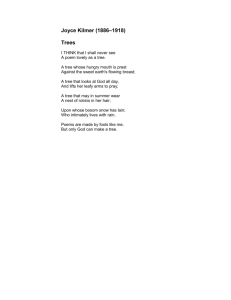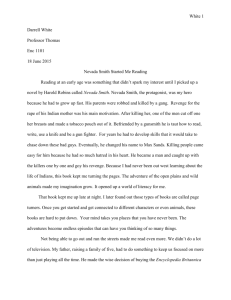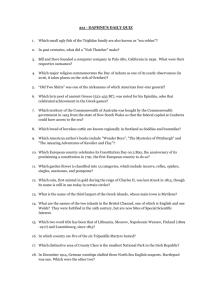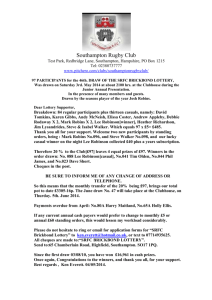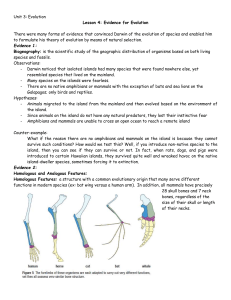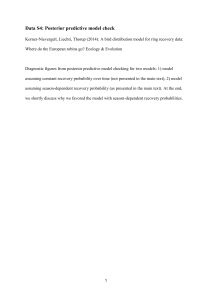Looking and Listening for Spring Robins
advertisement
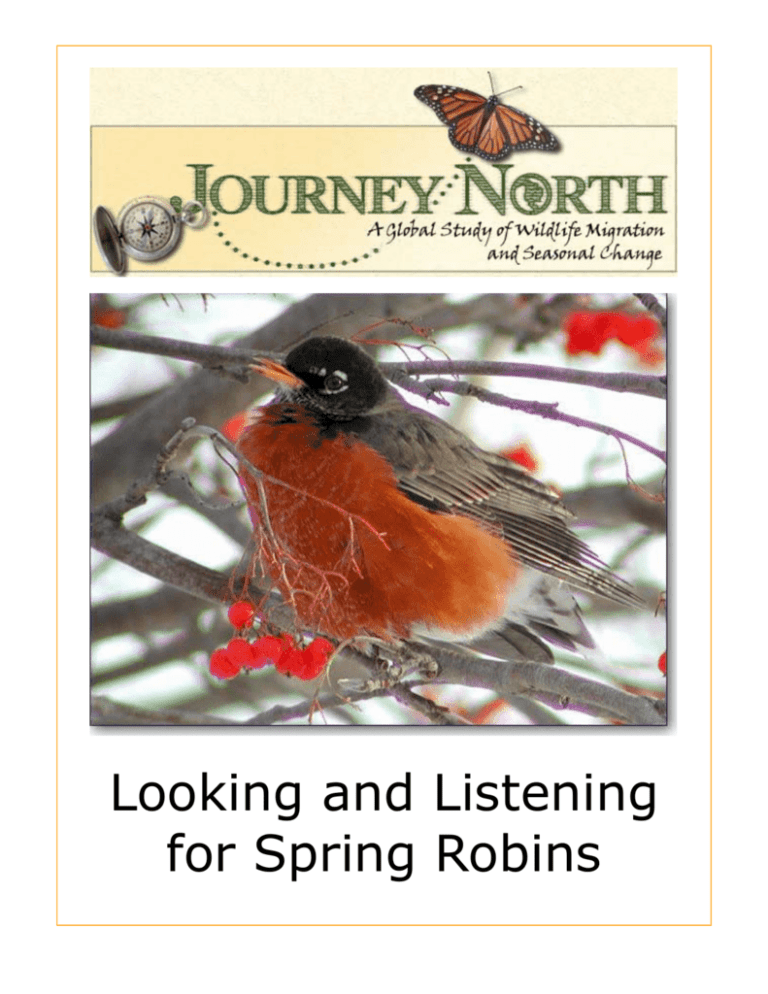
Looking and Listening
for Spring Robins
McKinze
Robins think your backyard is a territory. The mom lets the
eggs stay cool before the are laid. Most robins lay 3-4 eggs for
their first nest of spring. The baby hatches 12-14 days after the
last egg is laid.
Each baby robin when it’s
born weighs less than a
quarter. Eggs usually hatch
a day apart. Babies feel the
bounce on the nest when
the mom comes home with
food.
A robin may battle other males
for a good territory. Robins sing
right after they win a battle to
stake their claim.
Robins first fly when they are 13 days old. It takes another 1015 days to fly as well as their parents. Their parents are the
ones that teach them how to fly as well as them.
Rebecca
Most robins die during
their first year. Some
live to be 5 or 6. The
longest living robin
was 13 years and
11months in the wild.
In captivity some live
to be 17 years or
more.
If a baby robin falls or can’t
get back in its nest, you may
pick them up. You may raise
a baby robin. Make sure he
or she is fed as often as possible. If you have a dog, its
good if your dog is good
also it could be bad. If your
robin runs into a bad dog it
could get into some trouble.
If a male dies a
female will adapt
to another male
and will mate.
Don’t move a robins nest.
Their parents will abandon them. This happens if
you move a nest, because
the mother will not recognize it’s nest. If you do
move a nest, move it right
away or don’t move it at
all. Otherwise the mother
will not have time to lay
an egg.
Simon
Robins can only lay one egg a day, because they only have
one working ovary. Mammals have two which allows them to
have two babies. The robins ovary looks like a bunch of different sized grapes.
Robins usually stop laying eggs at four to five.
They stop when they
think there’s enough
eggs under them, even if
two or three eggs under
them.
The eggs have to be kept
warm to develop. A robins
temperature is around 105
degrees Fahrenheit. It’s
feathers keep its body heat
inside. A broad patch keeps
the eggs warm. The broad
patch is hidden so it doesn’t
get cold.
fighting its way out of the egg isn’t easy. first it pops a hole out
of the egg with its egg tooth. Then it rests to regain its energy.
When they hatch have to eat a lot of worms.
Zach
Out of five senses, Robins use
their vision the most. They
have poor taste and smell.
They normally look down the
hole before they grab the
worm. Their 3 good senses
are vision, touch and hearing.
Like most birds the robins
hearing is excellent.
If the female does
not mate the yolk will
not be fertile. The yolk
still will be an egg but
not become a robin.
When the yolk goes
through the oviduct, water with protein comes in.
How does a robin lay
eggs? A robin can only lay
one egg a day. They can
only lay one egg a day because their ovary is to
small to make more than
that. The yolk {what's in
the egg} runs through a
tube. This tube is called
the oviduct.
Robins have no defense
against cats. Cats are not native to the western hemisphere.
During migration robins can
get very tired and can become
easy prey for a cat. Keep your
cat indoors.
Kyla
Weigh, height, color
They weigh 64.8-84.2
grams, or 21/3-3 ounces. They are
9-11 inches long with wingspan of
14 3/4-16 1/2 inches. Robins are
orange and gray. Some are not.
Some are.
A Baby Robin’s Adventure
There is a baby robin in
a rain gutter. That must
have been fun. He might be
taking a bath. He might
want a drink too. He might
be waiting for his mom or
dad. He not.
might
First Song You Hear
Robins sing when
they arrive on there territories. They sing loudly.
They sing dawn
Song and song. They
also sing Whinny.
There Are Parents flying
There are parents flying
over a meadow. One is a male
and the anther is a female. They
might be looking for stuff to
build a nest. They might not
be. They only know.
Kaleb
The first robins of spring
are usually seen alone.
Later, groups or waves of
robins follow and are a sign
that the migration is taking
place in that area.
Where are robins during
the winter months? Robins
are commonly seen in large
flocks. We expect to receive reports of ’waves’ of
robins from these areas
during the winter months,
before the spring begins.
Whether you're in the north or south,
please report all sightings of flocks or
groups of robins as “waves”. We will
use the data to make a map
showing robin abundance on the wintering grounds and along the migration
trail.
Sawyer
Robins eat berries, fruit, and
invertebrates. Robins can easily switch from worms to fruits.
Robins can change nesting areas
if necessary.
Robins can be found in many places. These include: marshes, fields, forest borders, orchards,
hedges, cut over woods, gardens, urban areas and
so on.
Blue Jays and crows are robins enemies. They eat the baby
robins. Humans are one of the biggest threats because of toxins.
Robins lay eggs every year. Robins
lay eggs seven hours later than most
other birds. Robins spend 9-16 days in
a nest. Robins lay all their eggs before
sitting. Robins egg hatching temperature is about 104 degrees.
Garrett
Most Robins lay 3 or 4 eggs for their first nest in spring . For
their second or third nest they lay 2 or 3 nesting of the season
they just have 2 eggs . Eggs usually hatch a day a part. They
hatch in the same order they were laid.
A new baby Robin knows three
things .To sit still when its
mother or father are gone, to
open its mouth to beg for food,
when it is done eating it knows
to poop.
Robins do all sorts of things they fight, bath, hunt, sing, fly,
freeze when hawks come. A baby Robin learns to fly 2 to 3
weeks and they can hunt. A nest is about 2 inches high an 6
inches long. Robins are black, brown, red, gray, yellow. The
Robin comes back to New Auburn in the Summer. Robins or 6
to 11 inches wide and long.
They sing to communicate with
each other to hide, freeze from
hawks, and to hunt. Robins hunt
for worms, chipmunks, rats and
other birds.
Alexis
What happens to robins
when food is in scarce supply?
What 3 Things Does A Baby Robin
Know When It Hatches?
Robins can easily switch to eating a
lot of worms to almost entirely
fruits. When the ground starts getting cold in fall, they change their
diets. When worms are hard to find
robins eat fruit.
Baby robins know to sit very well
when their first born & when their parents are away. When the parents return
another thing they know how to do is
beg for the food when their parents return from hunting! The last thing a
baby robin knows how to do right
away when it is born is to poop right
away as soon as the baby robin swallows it’s food.
How Do Baby Robins Recognize
their Parents?
When baby robins hatch they might not
recognize their parents! They know how
their parents come back with food when
they feel the bounce on the nest. That’s
just on a dark & cloudy day. On a sunny
day they can tell by their parents shadow.
This is when they know to pop up with
their mouths open! Very slowly they learn
the sounds their parents make. By the
time their eyes eyes open they already
know their parents voice!
Do Robins Mate For Life?
Robins don’t stay with a mate for
life. 2 robins usually stay together
for a whole breeding. Which means
2-3 nestings. In spring sometimes a
male & a female who mated the
previous year will return where
they mated last year and will end
up mating again for another year.
This usually happens when they
were successful raising babies the
last year.
Courtney
Robins lay up to 4 eggs usually.
For it to do this it needs a mate. A
robins temperature needs to be
104 F, to keep the eggs warm.
The mother sits on her eggs 12 to
14 days. The mother only leaves
up to 5 to 10 minutes. The mother
robin has to rotate the eggs so the
other side of the egg can get
warm. When the baby or babies
are ready to hatch it isn’t easy for
them.
BABY ROBINS WELCOME TO
THE NEW WORLD
Robins enemies are jays, and
crows. They consider the
mocking bird, waxwings, and
other birds that compete for
fruits-are enemies. Cats are
also enemies. They chase
them away.
Then when they hatch
they aren’t the cutest
thing. They’re naked
with no feathers.
They’re eyes bulging
out. The dad then sits
on them and the mom
goes and gets food for
them. Then she pucks it
up for them. That’s how
they get fed.
Some robins can be white or
partly white. These are
called albino robins. For
some reason, albinism and
partial albinism have been
recorded more than any different wild bird species in
robins.
Zach
The first baby hatches in 1214 days. Each baby weighs
less then a quarter.
A female robins can carry
one egg in her body and
can’t fly with more then
one egg.
Robins can fly up to 20-36
miles per hour. When robins fly they are pitch black
dark. They can fly 450
miles without stopping.
Baby robins grow very fast.
They are the size of their
parents. Robins parents are
full time workers . They
feed their babies if hungry.
Tony
Food
Where do our robin go?
Here is what a robin eats. They
like to concentrate on berries,
trees and vines. On a warm day
they will be looking for worm. In
winter robins eat fruit and seeds.
Where do are robins go?
Down south were it’s either
warm or hot. In the winter
robins are in Florida.
How robins make a nest.
Territory
Male and female robins take
turns gathering nest martial. If
only one robin does the nest it
would take a lot of time. The
nest isn’t a home it’s a nursery.
Male robins pick a territory
then find a mate. Female robins return in two weeks to find
a mate. Sometimes females
fight to get the best mate
Jase
Feb 22, over 1,000 robins
were seen in the U.S.A. An
American robin stays in the
U.S.A. Robins eat a lot of
food like trout, snakes, insects, and fish when they are
dead. They love to eat
worms.
Robin’s get very fat. when they
have eggs. Robins lay two to
four eggs. Robin like to flock.
Robins have six different types of
songs that they sing. Each one has
a different meaning.
Garrett
Do robins need water
in winter? In northern climates where there is water,
a birds most available water is mostly snow. Birds
need to drink water in winter and if they can, bathe.
Dirty feathers lose most of
their warmth and if a bird is
clean it’s normally warm.
What color is robin
chicks? Their skin is light
and may appear yellowish.
It is so transparent that you
can see it’s gall bladder ,
purplish red liver, and orange
Why do robins lay their
eggs later in the day then
most song birds? Robins get
lots of their calories from the
worms they eat. They find
their worms by sight, so
there needs to be some light
to hunt. The robin eats first
thing in the morning.
How many eggs do
robins normally lay? Most
robins during their first
nesting normally lay three
to four eggs and very rarely
five eggs. This happens
more when a robin lays an
egg in an another robins
nest.
Hannah
Here Is A Robins
Lifetime
First the mother lays eggs.
The mother lets her eggs
stay cool. She keeps the babies the right temperature.
She uses about 50 min per
hour sitting on eggs. Most
robins lay 3 to 4 on first
nesting and 2nd and 3rd
nestings are mainly just 2.
Were are Robins in the
Winter?
Some robins stay at
certain places all year long
even in snow. Most robins
in the north migrate in the
south to find food. Some
robins fly far and some do
not. Robins live in cold if
they have food to eat to eat.
Male And Female
The male has brighter colors
and the females colors look
washed away. When they travel
in flocks. Over 100 of different
robins mostly males and few
females they come back around
April and May.
What Do Robins look for?
The robins think your back yard
is there home territory. There
territory is there mating and
nesting place. The first thing the
male does is find the best He
fly's over neighborhoods land
and other places to find high
trees.
Brandon
Robin first nest in the
spring
Can have 3 to 4 babies. Babies
hatch a day apart. The dad sits
on the eggs while the mom goes
for food. She eats the worm then
pucks it in the babies mouth.
The eggs
are the size of a
quarter. The are
blue all over.
They hatch a day
apart. The mom
sits on the eggs
for 12 to 14 days
before hatching.
Robins head
south in the winter
for food. Food
keeps them
longer. Males
need to eat
enough to get to
the mating areas.
It takes 2 to 6 days to
make a nest. They need twigs,
mud, and dry grass to make a
nest. There usually made in
pine trees.
It takes
twelve days before fully
grown. They
can stay in the
nest for 16
days. They stay
13 days before
kicked out of
the nest. There
great flyers in
10 to 15 days.
Chelsie
Robins eat all sorts of insects
and a gardener snakes and
trout when their dead. A male
robin is darker than a female
robin is lighter than a male
robin. When the robin makes
it’s nest it’s made out of
mud, and dead grass. The
first baby hatches 12-14 days
after the last egg is hatched.
The mother robin catches
worms eats the worms and
throws it up in the baby robins
mouth. Robins eat a lot of food
during migration. When robins
see danger, a person the leader
robin does the whinny call.
Robins return when the temperature is 36f º or above.
Baby robins remain in
nest about 13 days. The
parent robin eats the baby
robins fecal sac. In the
winter robins eat berry
seeds are important part
of a robins diet.
Robins have built
more than 20 or 30
nests. Robins build
nests in trees and other
structures robins lay
1-3 eggs a day.
Holly
American robins and waxwings are both flocking
species in winter that’s because both eat fruit.
Flocking is helpful because flocks have more
eyes to discover new
sources of fruit. Where the
find fruit, it’s abundant.
Lots of fruit means flocks
members don't have to
worry about competing.
Robin’s have
a loud song.
The song
helps warn
away
Colton
In most North American location, Robins nest twice
each year, and three times in
the same places!
It takes 2-11 days to make a
nest, 100 times for mud, 305
pieces of grass.
In most North American location, Robins
nest twice each year,
and three times in the
same places!
When Baby Robins
poop it is put in a
thick, strong bag for
their mother or father
to take away.
Austin
Robins are about three
ounces. They are sometimes
nine to eleven inches long with
a wingspan of fourteen to sixteen inches.
Adult robins are normally gray with their head,
wing, and tail dark gray.
Their throats are striped
black and white. They have
Robins fly about from
twenty to thirty-six miles per
hour. In migration season they
fly about thirty to thirty-six
miles per hour. In migration
Robins are always being
they travel from one hundred attacked by cats, hawks, and,
to two hundred miles per day. other animals.
After arriving back home the
male robins spend most time
feeding and singing.
Kansas
The mother robin lays one egg a day. First egg hatches 12-14
days after they mate. The mom lets them stay cool until they
are all hatched. Most robins lay 3-4 eggs their first nest in
spring, the second and third batch 2-3.Eggs hatch a day apart.
After five days they can eat, after two weeks they are as big as
there parents, after thirteen days they jump from nest.
The male robin finds the territory but if another male wants
that territory they fight until
one dies or one gives up. The
males always reach breeding
ground before female.
It takes two to six
days to build the
nest. The robins
build there nest in
the spring time.
The nest is seven
inches wide and
two inches tall.
Robins are capable
to build two nests
at once.
The adult robins are dark gray above
but on there tails, head, and wings almost black outer tail feather tipped
with white there breasts are dark
brown with rich dark brick red. Throat
is streaked black and white. Lower
tummy also white.
Emily
GO LAY AN EGG.
Mother robins lay one egg a
day. Carrying more than one
egg in her small body would
be like an airplane trying to
fly with to much on board.
First nest they lay 3-4 eggs.
Robins may have up to 5
nests each year.
Robins sing when they arrive.
As migration reports arrive,
usually in March, students can
track the migration in their
own backyards. When their
own robin reaches the end of
its migration, the bird announces its arrival by singing
its territorial song. Robins
song is the simplest method
for tracking spring robin migration.
A FAVORITE SIGN OF
SPRING
The robin has always
been a favorite sign of
spring in the northern regions. In the arctic, robins
don’t arrive until May because it is to cold down
there right away. It has to be
36 degrees Fahrenheit for
robins to arrive down there
right away.
Robins are in many places.
This map shows the range
of the American Robin. Do
you live in the robins summer range or all year range.
Quintin
Robin can live up
to 12 years. The robins
build up to 20 to 30
nest. They don’t have
blue prints they do it by
instinct. They need to
have a perfect nest for
there baby's. Have you
nodes that robins nest
are alike.
Baby's robins stay in the
nest for 13 days. About every
time a robins eat some thing
they Poop!! Lets see that’s 13
days times 4 baby's times 356
that’s a lot of poop. The mom
feeds the baby's so she eat
there poop grows!!!!!
In most north American
robins nest twice a year. And
three some times. Can you find
robins in yore neighborhood
If you think laying eggs is
easy think again. Robins lay
egg one per day that must be
hard. Female have one
wrecking ovary , unlike mammals, which have two.
Dalton
When the fruit stops growing in
winter sometimes molds form
but not right away. As the fruits
get old and stop getting fresh
supplies of sap it can turn toxic
and it can poison the bird and it
will die. Microscopic bacteria
and yeast spores produce organic
compounds such as alcohol in a
process called fermentation some
kinds of fruit like tatarian honeysuckle, nighshades, chinaberries,
and chokeberries produce other
kinds of toxins like saponian, solanine, and cyanide that can
paralyze nerves and even kill
animals.
When humans of animals eat
or drink toxic chemicals they
become intoxicated. When
someone is intoxicated their
movements are unbalanced and
we sometime laugh at it.
When birds are intoxicated
they have trouble perching.
They look for good fruit. Robins eat only fruit when they do
not have worms to eat. They
will not eat berries if they have
been frozen or have a bad
smell.
Some songbirds can detect odors
fairly well. This ability can help
birds detect berries. Although it
is easier to detect berries when
they aren’t frozen.
Kendall
If you raise a baby robin
on your own it couldn't
be ready one it’s own.
It couldn’t be ready it’s
own.
If you take the baby robin
away from it’s mother would
not come back to the nest.
If the father saw that
the mother was gone
the father would look
around and he would
kill the baby robin
before the mother came
back.
When the mother
comes back the mother
would see her babyrobins died from the
father robin. And then
the mother would go
get won of her friend to
watch her baby robin.
Nicole
When the days are cold the
robins search for food.
They try to eat as much as
they can. The left over berries after the long winter
are the worst. They eat a
lot of food during migration. They like to eat
worms and berries the
most.
Robins have six different types
of songs. They are: Dawn song,
peek and tut call, whinny, seeee
call, and zeeup call. Robins
sing when they arrive.
Robins must get fat so they can
fly long distances without stopping. Storing fat is bad for humans, but for robins they are
made to store fat in a healthy
way. They can fly. When they
lose the weight, they eat more.
The robin sings so you
know when he arrives. The
robins song is a way to track
robins. Robins are a song
bird. They sing many beautiful songs.
